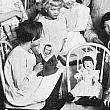
Mary Free Bed Guild
In 1891 a member of the United Benevolent Association Hospital, which is now Blodgett Memorial Hospital, learned while on a visit to Detroit that a hospital there had an endowed bed.
The bed was established by small contributions solicited from women whose names were Mary, and the board member brought back the idea with her. Another board member found an old purse containing six pennies and this was the start of a fund for an endowed bed in the U.B.A. Hospital.
In 1911 the fund had increased to $2,430 and an association was formed to increase the fund and carry on the work already begun. Thus, the Mary Free Bed Guild was born. In 1918 the group separated from the hospital and began working with the city in the care of crippled children.
From a small beginning has grown an establishment that is widely know throughout Western Michigan and the city and one that is worthy of any city.
The Guild then established a small convalescent home, but it was inadequate for the growing needs of the community and in 1934 an invitation was extended to share the D.A. Blodgett Home for Children. This it did and gradually assumed management and operation of the entire building.
Prior to that time—as far back as 1920—its first clinic for crippled children was established at Blodgett Hospital with Dr. John. T. Hodgen, director. By 1927 the Guild felt that, with the clinic now so well established, it should be turned over to the hospital to become a unit of its out-patient department.
In 1935, the Guild’s new home was designated the Orthopedic Center of Western Michigan by the Cripple Children’s Commission and in 1946 as the Juvenile Amputee Training Center and also as in-patient and out-patient clinic for cerebral palsy, and the Juvenile Paraplegic Training Center. In 1948 a rheumatic fever ward was approved.
For many years the women of Mary Free Bed Guild had cherished a dream—a dream of their own completely equipped hospital and to that end a building fund was established years ago, rigidly earmarked for building purposes only. This money came to the home through gifts by interested individuals, bequests from the Sligh Estate, State funds and—well, the entire program was made possible through the generosity of people interested in the development of children.
Then in 1949 the Delos A. Blodgett Estate deeded over the entire Cherry Street property to the Mary Free Bed Guild. The deed contained the name of Henry P. Erwin, Mrs. Pierre Gillard, and Delos A. Blodgett II, and it brought about the realization of this cherished dream.
With his gift of the Blodgett heirs the building problem was solved. The money previously acquired was devoted to the construction of additional facilities, extensive remodeling and modernization—an elevator and ramps, in addition to a recreational play ground which fortunately the size of the property made possible. Furthermore, it was mechanically equipped so that the handicapped children would have an even better opportunity to get well.
In November of 1945 a program was started to aid parents of cerebral palsied children in caring for these children in their homes whenever possible. From this beginning, a nursery school for the cerebral palsied was established in the Home jointly by the Junior League and the Mary Free Bed Guild, where a full-time teacher, a full-time physical therapist, and an occupational therapist are in attendance in addition to the medical staff. In 1947 approved out-patient clinics for cerebral palsy were established, while as late as 1951 an orthopedic clinic was approved by the Michigan Crippled Children’s Commission.
Excerpted from the "Peninsular Club Magazine," December, 1952, page 154

 facebook
facebook





